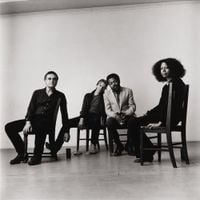
From the 1960s to the early '80s, Peter Hujar was an iconic presence in New York's downtown scene.
His celebrated portraits capture the city's queer pantheon of artists and drag performers, poets and writers, celebrities and deadbeats, strangers and lovers, acquaintances and friends. From East Village icons Greer Lankton and Ethyl Eichelberger to downtown intellectuals Susan Sontag and Fran Lebowitz, from Warhol superstars to legendary artists like Paul Thek and David Wojnarowicz, this exhibition brings together Hujar's penetrating portraits in a love letter to his city and community.
Cruising Utopia traces the horizons of Hujar's expansive body of work, encompassing intimate studio portraits, street photography, and striking images of the city itself. Across nighttime streetscapes, desolate parking lots, and crumbling piers peopled with half-naked bodies, Hujar photographed the margins of public space, capturing queer intimacy as it flourished in the post-Stonewall era of the '70s and early '80s. Cruising the city through his camera's viewfinder, he navigated its porous networks of erogenous utopias, photographing a fabulous and often infamous cast of underground elites who defined New York City's vibrant counterculture in the decade before AIDS.
In the mid-1960s, Hujar began making erotic portraits of subjects in his studio. The images he made of two men, Jay and Fernando, dressed in leather and locked in amorous embrace, are among the earliest such works.
Together with his boyfriend, gay rights activist Jim Fouratt, Hujar participated in the famous uprising against the violent police raid on the Stonewall Inn in June of 1969. Later that year, he shot the photograph for the now-iconic 'Come Out!' poster for the Gay Liberation Front.
Hujar met David Wojnarowicz—who was exactly twenty-years his junior—in a bar in the East Village in 1981. After a brief romance, they developed a deep, almost familial relationship that would last until Hujar's death from AIDS-related illness in 1987.
'David desperately needed a father, and as the shadows lengthened, Peter just as desperately needed a son,' writes Stephen Koch. 'David craved a mentor, a guide out of his chaos, someone who could see his soul. Peter craved renewal, restoration of his life, someone whose soul he could see and who was worthy of whatever Peter could give him."'
To commemorate Hujar's legacy during LGBTQ Pride Month, Pace Gallery and The Peter Hujar Archive will donate 10% of all sales from Cruising Utopia to the NYC AIDS Memorial, which honours the more than 100,000 New Yorkers who have died of AIDS and acknowledges the contributions of caregivers and activists who mobilised to provide care for the ill, fight discrimination, lobby for medical research and alter the drug approval process.
Peter Hujar photographed his subjects with penetrating sensitivity and psychological depth. Unflinching and at times dark, he captured intellectuals, luminaries, and members of New York City subculture in moments of disarmed vulnerability.
Hujar embraced male sexuality unabashedly, and was unafraid to examine death and dying. In her introduction to Portraits in Life and Death, Susan Sontag wrote, '...Fleshed and moist-eyed friends and acquaintances stand, sit, slouch, mostly lie—and are made to appear to meditate on their own mortality...Peter Hujar knows that portraits in life are always, also, portraits in death.' Hujar was at the forefront of the group of artists, musicians, writers, and performers in downtown New York in the 1970's and early 80's. He succumbed to AIDS in 1987, leaving behind a complex and profound body of work that has become posthumously celebrated.
Press release courtesy Pace Gallery.
540 West 25th Street
New York, 10001
United States
www.pacegallery.com
+1 212 421 3292
Tuesday – Saturday
10am – 6pm
![Peter Hujar, Jay and Fernando [Two Men in Leather Kissing] (ca. 1966) (detail). Vintage gelatin silver print. 27.9 cm × 17.8 cm, image 35.6 cm × 27.9 cm. © The Peter Hujar Archive.](https://files.ocula.com/anzax/43/43c1a1b3-7a47-4c9c-8ec6-9de5fa835f9e_400_250.jpg)
Peter Hujar, Jay and Fernando [Two Men in Leather Kissing] (ca. 1966) (detail). Vintage gelatin silver print. 27.9 cm × 17.8 cm, image 35.6 cm × 27.9 cm. © The Peter Hujar Archive.